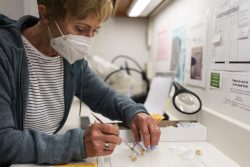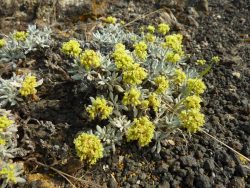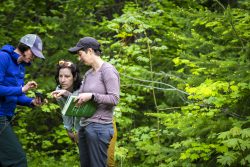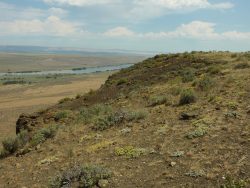
In 2017, nearly half the population of Umtanum Desert buckwheat (Eriogonum codium) was destroyed by a wildfire in Washington’s Hanford Reach National Monument. This unassuming perennial plant is not found anywhere else in the world — meaning catastrophic events such as this could eventually spell extinction for its corner of Washington’s rich biodiversity.
How do we protect rare, endemic plants as they come under increasing pressure from intensifying wildfires and habitat disruption? Following models established around the globe, the University of Washington Botanic Gardens (UWBG) have devised an extraordinary solution: the Miller Seed Vault, a climate-controlled repository where they can collect and store the seeds of endangered, threatened, and sensitive plants from across the state.
Devising a safety net
Entering the Miller Seed Vault feels like stepping into a large refrigerator. Tucked away at the UW Center for Urban Horticulture and run by UWBG’s Washington Rare Plant Care and Conservation (Rare Care) program, the vault was built in 2003 to facilitate rare plant research and preserve native populations. Now housing nearly a million seeds from about 140 species, it is the largest collection of its kind for rare native plants of Washington.

Most seed vaults in other parts of the world focus on preserving agricultural or medicinal plants. UWBG, however, is a part of the Center for Plant Conservation, a network of organizations across the U.S. dedicated to specifically preserving rare native plants.
“Seed banks are increasingly being recognized for their importance in conserving the genetic diversity of rare plant species that are vulnerable to climate change,” said Wendy Gibble, director of the Rare Care program. “It is critical that we bank these seeds now to capture their current genetic diversity before these populations go through severe reductions or are extirpated.”
With drastic environmental changes becoming the norm as a result of the climate crisis, the seed vault acts as a safety net. Should a natural disaster like a wildfire, rockslide, or flood wipe out a population, Rare Care is prepared to restore it.

Citizen scientists save the day
With the threat of wildfires increasing in Washington, Rare Care is having to act quickly to protect Umtanum Desert buckwheat. Its susceptibility to fire and low reproductive success make it one of the state’s most imperiled plant species.
Projects such as this are heavily reliant on a dedicated team of volunteer citizen scientists. “Volunteers are the linchpin of Rare Care,” said Christina Owen, director of UWBG. “They are critically important in making the program happen.” These citizen scientists log thousands of hours each year, traversing rugged ground to monitor endemic plant populations, collecting seeds for the seed bank, and meticulously cataloging and storing minuscule seeds.
Since the devastating fire in 2017, Rare Care has been working alongside the U.S. Fish and Wildlife Service and the Cowiche Canyon Conservancy to establish a secondary Umtanum Desert wheat population near Yakima to supplement the single native Hanford Reach population. Ideally, the success of this new Yakima population will ensure that if a disaster strikes its predecessors in Benton County, the Umtanum Desert buckwheat will live on.

Investing in an uncertain future
The Miller Seed Vault and the Rare Care program will continue to play a key role in preserving Washington’s natural heritage into the future. Staff and volunteers are actively working to protect other species of rare native plants, including Whited’s milk-vetch (Astragalus sinuatus), endemic to Wenatchee; showy stickseed (Hackelia venusta), one of Washington’s rarest endangered plants; and the Wenatchee Mountains checkermallow (Sidalcea oregana var. calva).
Owen and her colleagues see the vault as a long-term investment in the face of an uncertain future. “There are services that plants provide to humans that we’re still discovering,” she said. “So I think it’s really worthwhile to have a space where you can preserve them.”
The Miller Seed Vault was made possible thanks to funding from the Pendleton and Elisabeth C. Miller Charitable Foundation. They continue to provide support to the vault today and are vital partners in making the project possible.
To volunteer with the Rare Care program, contact Anna Carragee at rarecare@uw.edu.
Story by Amelia Wells

